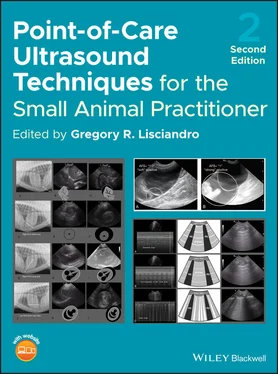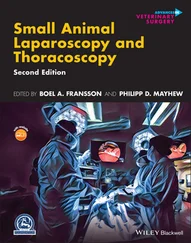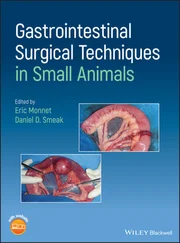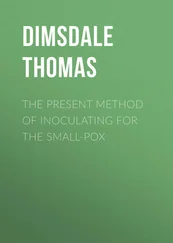The origin of a large midabdominal mass can sometimes be difficult to determine when the mass contacts multiple origins. In this case, try repositioning the patient from dorsal to lateral recumbency. This will often separate the liver and spleen from one another and help determine the origin of the mass.
Always look into the thorax through the diaphragmatic hepatic interface when evaluating liver to investigate the pleural and pericardial spaces, and the lung surface along the diaphragm.
An AFAST and assignment of an abdominal fluid score should be considered as routine for POCUS liver and gallbladder examinations and the Global FAST approach should be performed so as not to miss comorbidities including intraabdominal bleeding or peritonitis as well as intrathoracic conditions. The AFAST and its fluid scoring system should be used on initial patient evaluation and also to monitor for complications such as hemorrhage or peritonitis after interventional procedures including liver and gallbladder surgeries, percutaneous aspirates and biopsies, and laparoscopic procedures. The Global FAST approach is used for postinterventional intrathoracic complications including aspiration pneumonia (see Chapters 23and 36).
Quick Reference of Normals and Rules of Thumb
Liver assessment is subjective. Edges of the liver lobes should be sharply pointed. Rounded margins of liver lobes and hepatic extension (especially the left lobes) beyond the costal arch suggest enlargement. Abdominal radiography is more reliable for the determination of hepatomegaly.
Target lesions. Single target lesions have a high predictive value for malignancy. When multiple target lesions are seen, the positive predictive value of malignancy increases from 74% to 81% (Cuccovillo and Lamb 2002), and Global FAST is a rapid and quick assessment test for localized versus disseminated disease by surveying the remainder of the abdomen (AFAST), the thorax (TFAST) including heart (TFAST), and lung (Vet BLUE).
Normal echogenicity rule of thumb. The spleen (S) is more echogenic (hyperechoic) than the liver (Li) which is the same or slightly more echogenic (brighter) than the cortex of the kidney (CK), remembered as S > Li ≥ CK or by the mnemonic “SLiCK.” For the feline, hepatic echogenicity is often compared to the adjacent falciform fat and the feline liver should be isoechoic to slightly hypoechoic to the falciform fat.
Gallbladder wall thickness is normally <1 mm in cats and <3 mm in dogs (Hittmair et al. 2001; Spaulding 1993; Quantz et al. 2009).
Gallbladder luminal content is generally homogeneous anechoic bile although degrees of gallbladder sludge may be considered as clinically irrelevant or may indicate cholestasis based on the patient’s clinical profile (Tsukagoshi et al. 2012).
Being fluid filled, the gallbladder is subject to several artifacts including side‐lobe, slice thickness, edge shadowing, and acoustic enhancement in the far‐field; and the liver and gallbladder, being adjacent to the strong soft tissue–air interface between the diaphragm and the aerated lung, are subject to mirror image artifact.
In cats, tortuosity of the bile duct can be a normal variation; however, a bile duct greater than 4 mm (≥5 mm) is considered to be consistent with extrahepatic biliary obstruction.
When you are unable to effectively visualize the gallbladder using ultrasound (likely due to mineralized material or air), a good rule of thumb is to add radiography.
1 Choi J, Kim A, Keh S, et al. 2014. Comparison between ultrasonographic and clinical findings in 43 dogs with gallbladder mucoceles. Vet Radiol Ultrasound 55:202–207.
2 Crowe DT, Lorenz MD, Hardie EM, et al. 1984. Chronic peritoneal effusion due to partial obstruction caudal vena caval obstruction following blunt abdominal trauma: diagnosis and successful surgical management. J Am Anim Hosp Assoc 20:231–238.
3 Cuccovillo A, Lamb CR. 2002. Cellular features of sonographic target lesions of the liver and spleen in 21 dogs and a cat. Vet Radiol Ultrasound 43(3):275–278.
4 d’Anjou MA. 2008. Liver. In: Atlas of Small Animal Ultrasonography, edited by Penninck D, D’anjou MA. Ames: Blackwell Publishing, pp 243–247.
5 Fine DM, Olivier NB, Walshaw R, et al. 1998. Surgical correction of late onset Budd–Chiari‐like syndrome in a dog. J Am Vet Med Assoc 212(6):835–837.
6 Hittmair KM, Vielgrader HD, Loupal G. 2001. Ultrasonographic gallbladder wall thickness in cats. Vet Radiol Ultrasound 42:149–155.
7 Kolata RJ, Cornelius LM, Bjorling DE, et al. 1982. Correction of an obstructive lesion of the caudal vena cava in a dog using a temporary intraluminal shunt. Vet Surg 11:100–104.
8 Lisciandro GL, Harvey HJ, Beck KA. 1995. Automobile‐induced obstruction of the caudal vena cava in a dog. J Small Anim Pract 36(8):368–372.
9 Nelson NC, Drost WT, Lerche P, et al. 2010. Noninvasive estimation of central venous pressure in anesthetized dogs by measurement of hepatic venous blood flow velocity and abdominal venous diameter. Vet Radiol Ultrasound 51(3):313–323.
10 Nicoll RG, O’Brien RT, Jackson MW. 1998. Qualitative ultrasonography of the liver in obese cats. Vet Radiol Ultrasound 39(1):47–50.
11 Nyland TG, Mattoon JS, Herrgesell EJ, et al. 2002. Liver. In: Small Animal Diagnostic Ultrasound, 2nd edition, edited by Nyland TC, Mattoon JS. Philadelphia: WB Saunders, pp 93–127.
12 Quantz JE, Miles MS, Reed AL, et al. 2009. Elevation of alanine transaminase and gallbladder wall abnormalities as biomarkers of anaphylaxis in canine hypersensitivity patients. J Vet Emerg Crit Care 19(6):536–544.
13 Spaulding KA. 1993. Ultrasound corner: Gallbladder wall thickness. Vet Radiol Ultrasound 34:270–272.
14 Tsukagoshi T, Ohno K, Tsukamoto A, et al. 2012. Decreased gallbladder emptying in dogs with biliary sludge or gallbladder mucocele. Vet Radiol Ultrasound 53(1):84–91.
1 Harran N, d’Anjou MA, Dunn M, et al. 2011. Gallbladder sludge on ultrasound is predictive of increased liver enzymes and total bilirubin in cats. Can Vet J 52(9):999–1003.
2 Lisciandro GR. 2011. Abdominal and thoracic focused assessment with sonography for trauma, triage and monitoring in small animals. J Vet Emerg Crit Care 21(2):104–122.
3 Lisciandro GR, Lagutchik MS, Mann KA, et al. 2009. Evaluation of an abdominal fluid scoring system determined using abdominal focused assessment with sonography for trauma in 101 dogs with motor vehicle trauma. J Vet Emerg Crit Care 19(5):426–437.
Chapter Nine POCUS: Spleen
Stephanie C. Lisciandro and Sarah Young
The POCUS examination of the spleen is a valuable diagnostic tool for guiding clinical care and, with adequate care and awareness, can be effectively performed by a nonradiologist veterinarian. The POCUS spleen examination is not meant to replace a complete detailed abdominal ultrasound study by a veterinarian with advanced training (the veterinary radiologist or internist) but rather serves as a screening test for obvious abnormalities. Ultrasonographic findings involving the spleen may be subjective and nonspecific, including splenic size and generalized changes in echogenicity. Additionally, the frequent close anatomical contact of the spleen and liver can make it difficult to differentiate the origin of a mass, particularly for a less experienced sonographer.
As stated in Chapter 8, a concurrent AFAST examination should be performed with any of the POCUS abdominal organ examinations to rule out intraabdominal, retroperitoneal, pleural and pericardial effusions, and in the case of the POCUS spleen examination, to rule out splenic hemorrhage. The AFAST not only detects free peritoneal fluid but also semiquantitates its volume using its abdominal fluid scoring system and assigning an abdominal fluid score (see Chapter 6). The abdominal fluid score helps predict the degree of anticipated anemia in cases of hemoabdomen (Lisciandro 2011; Lisciandro et al. 2009). Global FAST is an even better approach to survey for pleural and pericardial effusion, cardiac and pulmonary abnormalities, and patient volume status. Moreover, Global FAST is used as a screening test to rapidly discriminate between localized versus disseminated disease, comorbidities, and complications, which may be especially helpful in hemoabdomen cases.
Читать дальше












